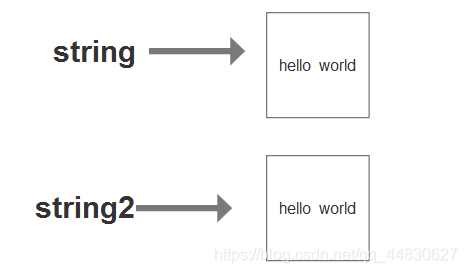1、相等性的比较(==)
1) 对于原生数据类型来说,比较的是左右两边的值是否相等。
2)对于引用类型来说,比较左右两边的引用是否指向同一个对象,或者说左右两边的引用地址是否相同。
2、java.lang.Object类
1):java.lang.Object类,java.lang包在使用时无需显示导入【java中这个包不需要显示导入,因为这个包很常用,Sun公司自动导入了】,编译时又编译器自动导入。
2): API(Application Programming Interface),应用编程接口。
public class HelloWorld {
public static void main(String args[]) {
Object object=new Object();
System.out.println(object);
System.out.println(object.toString());
}
}

3、当打印引用时,实际上会打印出引用所指对象的toString()方法的返回值,因为每个类都直接或间接地继承自Object,而Object类中定义了toString(),因此每个类都有toString()的这个方法。
public class HelloWorld {
public static void main(String args[]) {
Object object=new Object();
System.out.println(object);
System.out.println(object.toString());
String string="hello world";
System.out.println(string);
System.out.println(string.toString());
}
}

注意:String string=“hello world”;注意字符串String是一个特殊的类,在java中只有字符串可以这样直接的赋值,其它对象都是通过new的方式出来的,哪怕是单例也是new出来的。也可以这样写String string2=new String(“hello world”);
4、==的运用
public class HelloWorld {
public static void main(String args[]) {
Object object=new Object();
Object object2=new Object();
System.out.println(object==object2);
System.out.println("----------------------------");
String string=new String("hello world");
String string2=new String("hello world");
System.out.println(string==string2);
System.out.println("-----------------------------");
/*
*String Pool字符串池,string在String Pool创建了“hello world”的对象,string2就String Pool中不再创建“hello world”对象,但是会在堆中创建对象。即他们最终都会在堆(heap)中创建对象,然后把各自地址赋给string和string2。所以他们输出为false。
*/
String string3="hello world";
String string4="hello world";
System.out.println(string3==string4);
System.out.println("------------------------------");
/*
*String Pool字符串池,由于string3已经在String Pool中创建一个“hello world”的对象了,string4由于检查String Pool中已经有string3生成的那个“hello world”对象了,所以string4不再生成对象,直接把地址返回赋给string4,此时他们指向同一个对象,所以输出true。
*/
String string5="hello world";
String string6=new String("hello world");
System.out.println(string5==string6);
System.out.println("------------------------------");
String string7="hello";
String string8="he";
String string9="llo";
System.out.println(string7==string8+string9);
System.out.println("------------------------------");
System.out.println(string7=="he"+"llo");
}
}

【说明】:==用来比较两个对象的地址是否相等,:String Pool是在内存栈中,如果是new出一个实例的话是在内存的堆(heap)中生成一个对象。这两个在内存中的位置是不一样的。
String Pool(字符串池),Java中需要维护字符串池的是因为在实际开发中经常会遇到String,所以不用每次都在heap中去生成一个对象,而且这个对象用完一般都是丢掉的,所以需要维护字符串池,而且一般字符串写法用这种形式:String str = “hello world”。
/*
*虽然string和string2都是hello world,但是它们都new 了一个对象,两个对象的地址是不一样的,所以返回false
*/
String string=new String("hello world");
String string2=new String("hello world");
System.out.println(string==string2);
System.out.println("-----------------------------");

5、equals()
1)equals() 是定义在Object类中的
2)equals()的返回类型是boolean型的
判断当前这个对象跟其传进来的对象是否相等。
String string=new String("hello world");
String string2=new String("hello world");
System.out.println(string.equals(string2));
输出结果:true

3):equals()方法,该方法定义在Object类当中,因此Java中的每个类都具有该方法,对于Object类的equals()方法来说,它是判断调用equals()方法的引用与传进来的引用是否一致,即这两个引用是否指向的是同一个对象。对于Object类的equals()方法来说,它等价于==。
4):对于Object类的equals()方法来说是判断两个引用是否一致,是否指向同一个对象,而对于其他继承了Object类的其他类,如果它重写了Object类的equals()方法,它才是判断其内容是否一致,如果没有重写的话则和Object类的equals()方法判断方式一样。
public class HelloWorld {
public static void main(String args[]) {
Student student=new Student(18);
Student student2=new Student(18);
System.out.println(student.equals(student2));
}
}
class Student{
int age;
public Student(int age){
this.age=age;
}
}
输出结果:false
public class HelloWorld {
public static void main(String args[]) {
Student student=new Student(18);
Student student2=new Student(18);
System.out.println(student.equals(student2));
}
}
class Student{
Integer age;
public Student(Integer age){
this.age=age;
}
public boolean equals(Object object){
if(this==object){
return true;
}
if (object instanceof Student) {//instanceof用来测试一个对象是否为一个类的实例
Student student4=(Student)object;
if (student4.age.equals(this.age)) {
return true;
}
}
return false;
}
}
输出结果:true
6、String
String是常量,其对象一旦创建完毕就无法改变。当使用+拼接字符串时,会生成新的String对象,而不是向原有的String对象追加内容。
